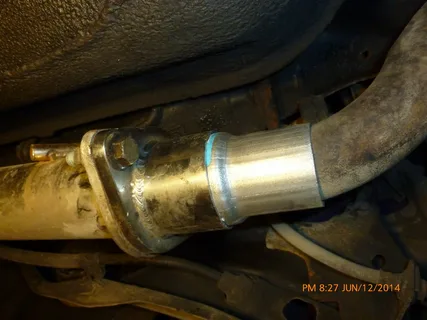If you’re looking for a reason to procrastinate on that pesky car repair, we’ve got just the thing: an exhaust leak at the flange! We know, it sounds like a total pain to deal with. But trust us, it’s actually not that bad. In fact, with our helpful tips, you’ll be able to fix that exhaust leak in no time!
What is an Exhaust Leak at the Flange?
Contents
An exhaust leak at the flange is a common problem that can be caused by several different factors. The flange is the point where the exhaust pipe meets the engine, and it is held together by a series of bolts. Over time, these bolts can become loose or even break, causing the exhaust pipe to become detached from the engine. This can lead to noisy engine operation, as well as decreased performance and fuel economy. In some cases, it can even cause engine failure.
What Are the Symptoms of an Exhaust Leak at the Flange?
If you have an exhaust leak at the flange, it is important to get it fixed as soon as possible. An exhaust leak can be very dangerous and can lead to carbon monoxide poisoning. Some of the symptoms of an exhaust leak at the flange are:
- A hissing or popping noise coming from your engine
- Your engine running rough or misfiring
- Decreased fuel economy
- Increased engine noise
- Exhaust fumes coming into your car
What Are the Causes of an Exhaust Leak at the Flange?
One of the most common places for an exhaust leak is at the flange, where the pipe connects to the muffler. Over time, the bolts that hold the flange together can loosen and break, causing an exhaust leak. Another common cause of exhaust leaks at the flange is rust. If the flange is not made of stainless steel, it can rust over time, causing it to break and allowing exhaust to leak.
How Can You Prevent an Exhaust Leak at the Flange?
You can prevent an exhaust leak at the flange by following a few simple tips. First, make sure that your exhaust system is properly installed. Second, use the correct size and type of gasket for your flange. Third, use high-quality exhaust clamps to secure the flange. Fourth, check your exhaust system regularly for leaks.

How Can You Repair an Exhaust Leak at the Flange?
There are a few ways that you can repair an exhaust leak at the flange. One way is to use a patch kit. This will involve putting a piece of metal over the hole in the flange and then bolting it in place. Another way is to weld the flange back together. This is a more permanent solution but it will require a welder.
What Are the Consequences of an Exhaust Leak at the Flange?
An exhaust leak at the flange can cause a number of problems, depending on the severity of the leak. A small leak can cause your car to run less efficiently, and a larger leak can cause your car to backfire or stall. In extreme cases, an exhaust leak at the flange can cause your car to overheat or catch fire.

How Can You Troubleshoot an Exhaust Leak at the Flange?
If you have an exhaust leak at the flange, there are a few things you can do to troubleshoot the problem.
First, check the bolts that secure the flange to the exhaust pipe. If they are loose, tighten them with a wrench. If they are already tight, then the leak may be coming from a gasket that has failed. Inspect the gasket for cracks or holes, and replace it if necessary.
Another possibility is that the leak is coming from a crack in the exhaust pipe itself. Inspect the pipe carefully for any cracks or holes, and repair or replace it as necessary.
If you cannot determine the source of the leak, then it may be necessary to take the vehicle to a mechanic or exhaust specialist for further diagnosis and repairs.
What Are the Common Mistakes Made When Repairing an Exhaust Leak at the Flange?
There are a few common mistakes made when repairing an exhaust leak at the flange. The first is not removing all of the old gasket material from the flange surfaces. If any of the old gasket material is left on the flange, it can prevent the new gasket from sealing properly.
The second mistake is not properly torquing the bolts that hold the exhaust pipe to the flange. If the bolts are not torqued to the proper specification, they can come loose and allow exhaust gases to escape.
The third mistake is not using an anti-seize compound on the threads of the bolts. This can cause the bolts to seize in place, making them difficult to remove if they need to be replaced in the future.
Fourth, be sure to use a quality gasket when replacing an exhaust pipe gasket at the flange. Cheap aftermarket gaskets may not seal as well as original equipment manufacture (OEM) gaskets, and they may not last as long.
Finally, don’t forget to inspect other exhaust system components for leaks while you have everything apart. It’s much easier to make repairs now than it is after everything is reassembled.
